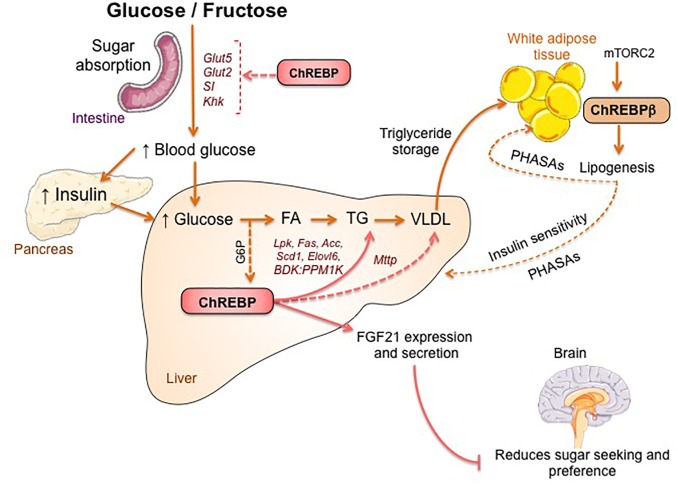FIGURE 2.
ChREBP regulates multiples signaling/metabolic pathways in response to glucose and fructose. ChREBP is expressed in several tissues including intestine, liver and white adipose tissue. In these cell types, in response to glucose and/or fructose ChREBP is activated and induces specific genic program as indicated on the figure. In intestine, stimulation of SI, Glut5, Glut2 and Ketohexokinase (Khk) expression by ChREBP (either directly or indirectly) was described to improve sucrose tolerance and fructose absorption. In liver, ChREBP is a key modulator of glycolytic, lipogenic and microsomal triglyceride transfer protein (Mttp) gene expression, thereby controlling both fatty acid accumulation and VLDL export from the liver. ChREBP is also regulates the production of hepatokines such as fibroblast growth factor 21 (FGF21). This liver-to-brain axis expands liver ChREBP function from a hepatic regulator to a systemic modulator affecting not only substrate handling in liver but also nutrient preference. ChREBP activation in white adipose tissue is linked to improved metabolic homeostasis by producing protective circulating signals. A novel class of mammalian lipids characterized by a branched ester linkage between a fatty acid and a hydroxy-fatty acid (palmitic acid hydroxyl stearic acid) was reported to exert beneficial effects on glucose homeostasis through direct and incretin-mediated modulation of β cell function, enhanced adipose glucose uptake and reduced inflammation. Interestingly, mTORC2 was recently identified as a novel regulator of ChREBPβ isoform in adipose cells.

